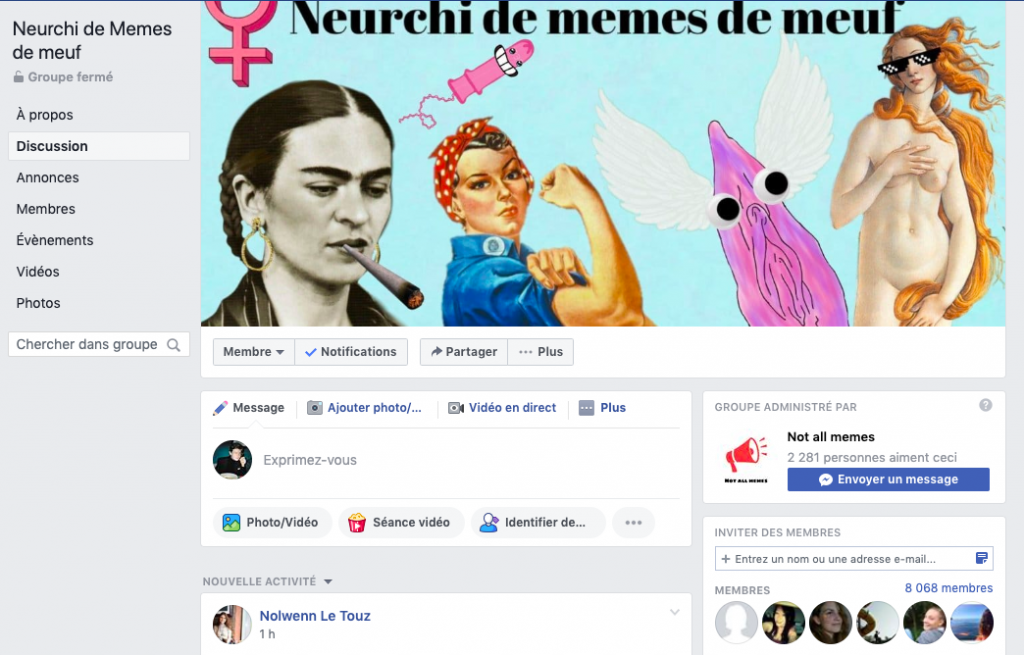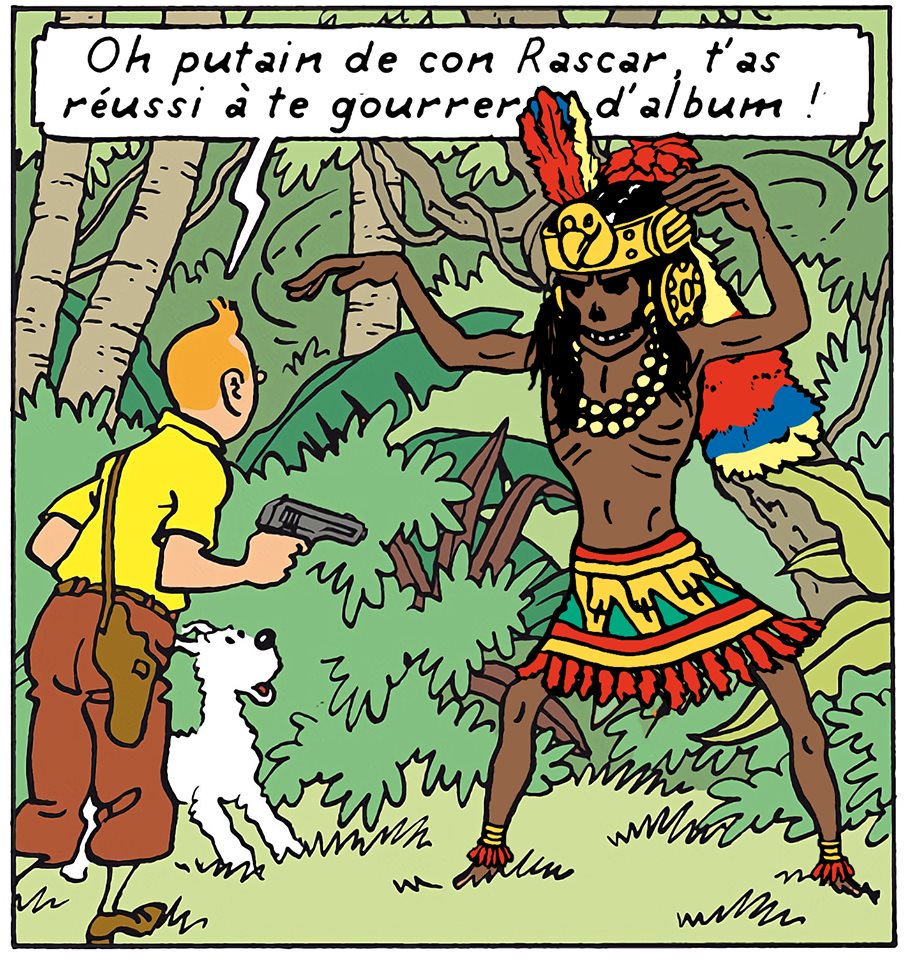Neurchi d’algorithmes
Introduction
In November 2016 I was in a pub with a friend complaining about how limited French memes were. Although France had a rich history in the cyberspace, it seemed that it missed the meme train. A year after, those complaints were laughably outdated.
Throughout 2017 the neurchis took over French Facebook. Neurchi is a vernacular expression combining “neurochirugien” and “chineur” (meaning respectively neurosurgeon and bargain hunter). It designates a Facebook group in which users congregate to share memes around a particular topic. Original content is very appreciated and since their inception they have become the driver of France’s meme industry. They are a living proof of how a small change in a platform’s affordance can create a social phenomenon.

A new business model
In 2017, Facebook was at a crossroads: the company finally hit the mark of 2 billion users worldwide, but its business model was starting to lag. People had a Facebook profile, but they did not spend their time on Facebook. A shift was necessary; and it took the form of groups (Shanani).
Like any object, Facebook present a series of affordances, that is to say, “dynamic link between subjects and objects within sociotechnical systems” (Davis & Chouinard 241) The algorithmic change of 2017 modified the its affordances to encourage its users to create, join and moderate groups (Deve). Facebook remained a space in which heterogeneous relationships were configured to produce affects, as Bucher defined it (481), but the focus changed from friendships between users to collective spaces in which users could find strangers with similar interests.
Enter the neurchis
Shortly after these changes were implemented, Facebook meme groups flourished. Some of the most popular neurchis date from the months following the announcement: neurchi de commentaires (40.000 members), neurchi de memes historiques (26.000 members) or neurchi de memes d’actualités (18.000 members) were all created in 2017.
These groups were coupled with the emergence of vernacular peripheral media surrounding the neurchis, such as the Wiki Neurchi, Instagram profiles relaying the best memes published in the Facebook groups and a Facebook page called “Neurchi”, which very clearly missed the point of the whole thing.
The neurchisphère has continued to steadily grow since then. A number of media outlets have decided to run articles on the phenomenon (Glad [1]; Cassely; d’Estienne d’Orves) and famous personalities make regular appearances in neurchis related to their work. After two years, the neurchis have obtained a prominent place in France’s cyberspace.
But why did Facebook groups become meme hubs there and not in other countries?
The French Touch (or lack thereof)
The journalist Vicent Glad ([2]) offered a possible answer in an article devoted to understanding why France’s meme production was not comparable to that of the U.S., Japan or Finland. Glad pointed out that massive meme creation is associated with imageboards. Since France doesn’t have a vernacular imageboard of its own, it is more than likely that many French meme creators post in American spaces, where English is the dominant language and references overwhelmingly belong to Anglo-Saxon culture.
Another element of this puzzle can be the bad reputation of the French cyberspace’s few vernacular platforms. For instance, France’s largest forums are routinely accused of connivance with the far-right (Audureau), justifying terrorist attacks (Petit) and orchestrating cyberbullying campaigns (Kucinskas). Despite their popularity in certain circles, these spaces are largely frowned-upon by the internauts and are not perceived as a welcoming community for incipient meme producers.
Facebook as an answer
In 2017 Facebook no longer wanted to go wide, it wanted to go deep. The shift towards groups was meant to change the way in which people used their platform by providing different interfaces for users to post different content. Mark Zuckerberg provided a clear example when he talked about Lola Omola during his speech introducing the new changes. Lola Omola is a Nigerian woman who created a secret group called Women IN, in which women all around the world could talk about their experiences in a safe space. Facebook could be both a public space where one enacts digital personhood and a personal space where one can share experiences with a small community.

I am pretty certain that the executives that came up with this idea were not expecting to have a group where people meme frantically about a very minor character of The Adventures of Tintin. Yet, they conceived an architecture that made it possible. They created easily accessible sites with precise context in which meme creators could find a like-minded audience while enjoying both personal recognition within the community and a certain level of anonymity outside of it.
Networked Publics?
The neurchis are one of the best examples of what danah boyd called “networked publics”. boyd defined them as “simultaneously (1) the space constructed through networked technologies and (2) the imagined collective that emerges as a result of the intersection of people, technology, and practice” (39). I cannot find a better way of presenting this phenomenon than boyd’s definition
Yet, she also argued that networked publics confronted people with a set of specific dynamics, namely invisible audiences, collapsed contexts and blurred lines between the public and the private. Such confrontation would result in the redrawing of traditional social constructions to adjust to the cyberspace (49-51).
What’s fascinating about the neurchis is that they are spaces where none of the dynamics outlined by boyd apply. Facebook understood that if they wanted to engage more people, they had to sanitise their sites, allowing mass participation without a fundamental questioning of social norms. This doesn’t mean those norms are not organically changing with the platform, but it is interesting to notice that Facebook consciously tried to minimise those changes through its affordances.
The speech by Marc Zuckerberg that I quoted earlier is quite pompous. In the conclusion he goes as far as to claim that Facebook Groups will empower Nigerian women to speak up and change society. With a two-year hindsight, we can say that they have empowered French memers. By changing and sanitising the affordances of its group platform, Facebook created a space in which a new, vernacular, community could emerge and raise to the forefront of a country’s humour. It might not be as grandiose, but it is a pretty remarkable social phenomenon.
Bibliography
Audureau, William. “Les Trolls Sur Internet, Nouveaux ” Colleurs D’affiches ” Du Front National.” Le Monde.fr, Le Monde, 31 Mar. 2017,
boyd, dannah. “Social Network Sites as Networked Publics: Affordances, Dynamics, and Implications.” In Networked Self: Identity, Community, and Culture on Social Network Sites (ed. Zizi Papacharissi), 2010, pp. 39-58.
Bucher, Taina. ‘The Friendship Assemblage: Investigating Programmed Sociality on Facebook’. Television & New Media, vol. 14, no. 6, Nov. 2013, pp. 479–93. DOI.org (Crossref), doi:10.1177/1527476412452800.
Cassely, Jean-Laurent. “Mèmes Décentralisés, Ou La Transition Numérique Des Blagues De PMU.” Slate.fr, 3 Sept. 2019, http://www.slate.fr/story/181242/memes-decentralises-france-rurale-humour-pmu-groland-lien-social.
Davis, Jenny L., and James B. Chouinard. ‘Theorizing Affordances: From Request to Refuse’. Bulletin of Science, Technology & Society, vol. 36, no. 4, Dec. 2016, pp. 241–48. DOI.org (Crossref), doi:10.1177/0270467617714944.
d’Estienne d’Orves, Lola. “Tu Cherches Une Raison De Rester Sur Facebook? Les Neurchis Sont Là Pour Toi.” Newsmonkey, 19 Aug. 2019, https://fr.newsmonkey.be/tu-cherches-une-raison-de-rester-sur-facebook-les-neurchis-sont-la-pour-toi/.
Deve, Alex. “New Features for Groups to Build Communities.” Facebook Newsroom, 26 Oct. 2017, https://newsroom.fb.com/news/2017/10/new-features-for-groups-to-build-communities/.
[1] Glad, Vincent. “Memes Radicaux Autogérés Pour Prolétariat Millenial.” Blogs.liberation.fr, 9 May 2018, http://an-2000.blogs.liberation.fr/2018/05/09/le-blague-bloc/.
[2] Glad, Vincent. “Les Mèmes Français Sont-Ils Si Nuls ? .” Blogs.liberation.fr, 2 Nov. 2017, http://an-2000.blogs.liberation.fr/2017/11/02/les-memes-francais-sont-ils-si-nuls/.
Kucinskas, Audrey. “‘Tu Paieras’: Nadia Daam Menacée Après Une Chronique Sur Jeuxvideo.com.” LExpress.fr, 2 Nov. 2017, https://www.lexpress.fr/actualite/medias/tu-paieras-nadia-daam-menacee-apres-une-chronique-sur-jeuxvideo-com_1957180.html.
Shahani, Aarti. “Facebook Changes Its Mission With Announcement About Groups.” NPR, NPR, 22 June 2017, https://www.npr.org/sections/alltechconsidered/2017/06/22/534018001/facebook-changes-its-mission-with-groups-announcement?t=1569006964797.
Smee, Ben. “Facebook’s Data Changes Will Hamper Research and Oversight, Academics Warn.” The Guardian, Guardian News and Media, 25 Apr. 2018, https://www.theguardian.com/technology/2018/apr/25/facebooks-data-changes-will-hamper-research-and-oversight-academics-warn.
Petit, Thibaut. “Antisémitisme, Homophobie, Fanatisme : Jeuxvideo.com, La Ruche à Fiel.” L’Obs, 27 Sept. 2015, https://www.nouvelobs.com/medias/20150924.OBS6430/antisemitisme-homophobie-fanatisme-jeuxvideo-com-la-ruche-a-fiel.html.


